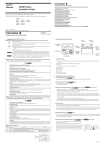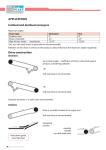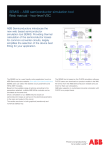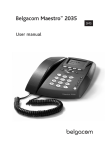Download User Manual – One Man Rigging Aid (OMRA)
Transcript
User Manual – One Man Rigging Aid (OMRA) One Man Rigging Aid is a simple mechanical device, which enables user to rig the wings of the glider in one man. Glider assembly/disassembly: 1. Allways park the trailer on a place with even surface without slope and with sufficient space. OMRA enables to rig the glider on a grass surface without roughness and holes. Do not use it on soft, muddy or uneven terrain. 2. Put the fuselage out of the trailer and prepare it for the installation of the wings. Prepare the main bolts. 3. Remove the securing arm from the OMRA´s wing holder, extend the help carriage with two swinging wheels and place the device next to the rear part of the fuselage. The proper position depends on the wingspan and weight of the wing (described lower). 4. Loosen the adjusting screw on the main wheel axle and slide OMRA as close as possible to the fuselage. It is recommended to adjust the heigh to the lowest position, it does not obstruct then when pulling the wing out of the trailer. 5. Pull the wing out of the trailer and put it approximately in half ot the leght in the wing holder of OMRA. It is recommended to let 15-20kg of the weight at the root spar by heavier wings (over 65kg). This helps the future adjustment of the OMRAs height. 6. Insert the securing arm an tighten it up with the screw. The arm is adjustable in two axis. This closes the wing in the wing holder. 7. Adjust the main wheels axle to the center position and tighten the screw. The center position enables easy adjustments of the wing position. 8. Hold the wing for the spar root and drive the wing in vertical position to the rigging position perpendicuar to the fuselage. 9. Turn the wing carefully to the horizontal position. By the first rigging check the best of four possible positions of the main bolt of the wing holder. Use the position, which provides easy turning of the wing from vertical to horizontal position and by which the force on the endstop in horizontal position is only few kgs. This provides the best stability and manipulation with the wing. 10. Insert the spar root in the fuselage as far as possible and adjust the height of OMRA if needed: push slightly with your shoulder up against the low side of the wing and simulatenously loosen the main adjusting screw. The gas spring will now help you to adjust the height quickly with small additional force. Than tighten the screw well up. You can also adjust the front/rear position of the wing with swinging of OMRA at the main wheels axle (±7,5cm, which is ±15cm at the wingtip) 11. After adjustment to the proper position stand to the leading edge, take the wing for the trailing and leading edge and insert it to the bolts/pins of the fuselage. Adjust once more the position of the wing for easy inserting of the second wing. The position of the first wing and its spar root is easy to check from the other side of the fuselage. 12. Support the first wing with the wing support and remove the securing arm from the wing holder. Now loosen the main adjusting screw and by pushing a bit to the wing from the upper side adjust the height of OMRA to lover level, then tighten the screw again. This will help you to remove OMRA from under the wing. (suggestion: if you tilt the helping carriage, you can pull OMRA behind you as a wheeled suitcase, don´t need to carry the heavy device in hands) 13. The same procedure repeat with the second wing. The only difference it that the insertion of the second wing to the bolts/pins is possible only after perfect adjustment of the wing position. Especially by modern gliders with bolts at the ends of spar roots (Discus, Ventus, G-304 and so) the adjusment must be done really precise and one needs a bit of practise. We recommend to train this phase few times and to memorize the proper position of both wings. Do not forget that the wing supported in its half by OMRA could apper in different position than the wing holded by a helper at the tip. Attention: 1. We do not recommend to use OMRA on soft, mushy or uneven surface or surface with holes from rodents. OMRA can be successfully used on common lawn. 2. We also don´t recommend rigging with OMRA by strong wind. If needed, always use second person to secure the other end of wing. The wind could cause strong forces on huge surface of the wing. 3. Always check the device before use. Check the completeness of OMRA and tight of all adjusting elements, pins. Please consult every more serious damage with the producer before next use. 4. Always return the main wheel axle to the middle position before manipulating with the wing. It improves the stability. 5. Always extend the helping wheels when de-rigging the glider. OMRA would fall without them extended when you remove the wing and the fuselage could be scratched. 6. Maintain at least 2 bars tire pressure for proper function and good stability (max. 2,5bar) Disclaimer: OMRA was succesfully tested with many different types of gliders at the beginning of 2008. By the use in concert with this user user manual and by calm and deliberately work the glider can not be damaged. The producer does not answer for any damages caused by use of this device.














